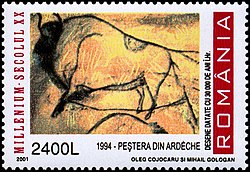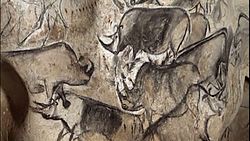Chauvet Cave
The Chauvet Cave [1] or Chauvet-Pont-d'Arc Cave is near Vallon-Pont-d'Arc, in the Ardèche département, in southern France. It became famous in 1994 when Paleolithic artwork was found on the walls. There were remains of many animals, some which are now extinct. Also some footprints of animals and humans were found. The cave is one of the most significant prehistoric art sites, like Lascaux, Altamira, and Cosquer.
Features
The gorges of the Ardèche region have many caves. Many have geological or archaeological importance. The Chauvet Cave is unusually large. Its artwork is well preserved and of good quality. It was occupied by humans at two different times: the Aurignacian and the Gravettian. Most of the artwork dates to the earlier Aurignacian era (30,000 to 32,000 years ago).
The only traces left of the later occupation during the Gravettian include a child's footprints, the charred remains of ancient hearths and carbon smoke stains from torches that lit the caves. It seems nobody had been in it after the child, until it was discovered in 1994.[2] The footprints are some of the oldest human footprints in existence: they are between 20,000 and 30,000 years old.[3][4]
The floor of the cave is of a soft material, almost like clay. There are paw prints of cave bears. There are also large rounded depressions in the floor. These are believed to be the nests where the bears slept. There are many fossilized bones, including the skulls of cave bears and the horned skull of an ibex.
There are hundreds of animal paintings there. At least 13 different species, including those which have rarely or never been found in other ice age paintings are represented. In addition to commonly hunted animals: horses, cattle, reindeer, etc.. The walls of the Chauvet Cave are covered with predatory animals: lions, panthers, bears, owls, rhinos and hyenas. Typical of most cave art, there are no paintings of complete human figures, although there is one possible, partial "Venus" figure that may represent the legs and genitals of a woman. A peculiar figure appears to have the lower body of a woman with the upper body of a bison. There are a few panels of red ochre hand prints and hand stencils made by spitting pigment over hands pressed against the cave surface. Abstract markings—lines and dots—are throughout the cave. There are also two unidentifiable images that have a vaguely butterfly shape to them. This combination of subjects has led experts in pre-historic art and cultures to believe that there was likely a ritualistic, shamanistic, or magical aspect to these paintings.
The artists who produced these unique paintings used techniques not often observed in other cave art. Many of the paintings appear to have been made only after the walls were scraped clear of debris and concretions. This left a smoother and noticeably lighter area upon which the artists worked. Similarly, a three dimensional quality is achieved by incising or etching about the outlines of certain figures. This visually emphasizes some of the animals and allows torch light to cast shadows about the edges.
Dating
The cave contains the oldest known cave paintings, based on radiocarbon dating of "black from drawings, from torch marks and from the floors." Clottes concludes that the "dates fall into two groups, one around 27,000-26,000 BP and the other around 32,000-30,000 BP."[5] As of 1999, the dates of 31 samples from the cave had been reported, with the earliest being 32,900±490 BP.[6]
However, some archaeologists have questioned these dates.[7]
History
The cave was named after Jean-Marie Chauvet, who discovered it on 18 December 1994, together with Christian Hillaire and Eliette Brunel-Deschamps. The researchers found that the cave had been untouched for 20,000-30,000 years.
Chauvet Cave Media
Image of steppe wisent (Bison priscus). Paintings in the Chauvet Cave on post stamp of Romania 2001
Cave hyena (Crocuta crocuta spelaea) and European leopard (Panthera pardus) painting
Related pages
Notes
- ↑ French: La Grotte Chauvet
- ↑ Curtis, Gregory 2006. The cave painters: probing the mysteries of the world's first artists. New York: Knopf, pp. 215-216
- ↑ ""Human footprints at Chauvet Cave"". Archeology. 52 (5). 1999.
- ↑ "Footprints may be oldest in Europe, French say". New York Times. 1999.
- ↑ Quotes from Clottes (2003b), p. 214.
- ↑ Clottes (2003b), p. 33. The oldest is sample Gifa 99776 from "zone 10". See also Chauvet (1996), p. 131, for a chronology of dates from various caves. Bahn's foreword and Clottes' epilogue to Chauvet (1996) discuss dating.
- ↑ Züchner, based on his archaeological dating, is of the opinion that the red paintings are from the Gravettian period (c. 28,000–23,000 BP) and the black paintings are from the Early Magdalenian period (early part of c. 18,000–10,000 BP).Züchner, Christian (September 1998). "Grotte Chauvet Archaeologically Dated". Communication at the International Rock Art Congress IRAC ´98. Retrieved 2007-12-23.
Clottes (2003b), pp. 213-214, has a response by Clottes. Pettitt and Bahn believe the dating is inconsistent with the traditional stylistic sequence and that there is uncertainty about the source of the charcoal used in the drawings and the extent of surface contamination on the exposed rock surfaces. Pettitt, Paul; Paul Bahn (March 2003). "Current problems in dating Palaeolithic cave art: Candamo and Chauvet". Antiquity. 77 (295): 134–141. doi:10.1017/S0003598X00061421. S2CID 161903280..New stylistic studies show that some gravettian engravings are superimposed on black paintings proving the paintings older origins (see E.Guy).
References
- Chauvet, Jean-Marie; Eliette Brunel Deschamps and Christian Hillaire (1996). Dawn of art: the Chauvet Cave. Paul G. Bahn (foreword), Jean Clottes (epilogue). New York: Harry N. Abrams. ISBN 0810932326.
- English translation by Paul G. Bahn from the French edition La Grotte Chauvet
- Clottes, Jean 2003a (2003). Return to Chauvet Cave, excavating the birthplace of art: the first full report. London: Thames & Hudson. p. 232. ISBN 0500511195.
- Clottes, Jean (2003b). Chauvet Cave: the art of earliest times. University of Utah Press. ISBN 0874807581.
- Translation of La Grotte Chauvet, l'art des origins, Éditions du Seuil, 2001
Other websites
- http://www.culture.gouv.fr/culture/arcnat/chauvet/en/ French Ministry of Culture information site; includes an interactive map with photos.
- http://www.france.diplomatie.fr/label_france/ENGLISH/SCIENCES/CHAUVET/cha.html
- http://www.time.com/time/europe/wonder/chauvet.html Archived 2005-09-11 at the Wayback Machine A brief article by Jean Clottes of the French Ministry of Culture, responsible for overseeing the authentication of the contents and art of the cave
- http://www.metmuseum.org/toah/hd/chav/hd_chav.htm Metropolitan Museum of Art showing the Chauvet Cave on its Timeline of Art History page
- http://www.neara.org/MiscReports/04-18-03.htm Archived 2007-06-28 at the Wayback Machine Doubt cast on Chauvet cave dating
- Chauvet Cave The cave paintings and rock art of Chauvet, with contributions by Dr Jean Clottes.
- http://www.paleoesthetique.com/articles_us/the_grotte_chauvet.php Archived 2008-05-26 at the Wayback Machine A new stylistic approach on Chauvet






